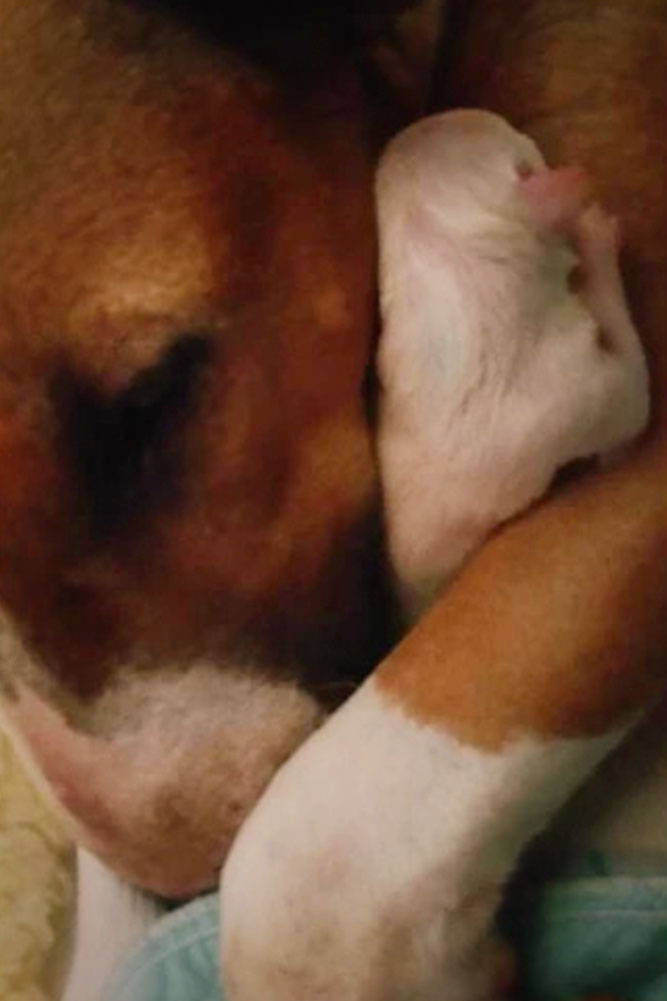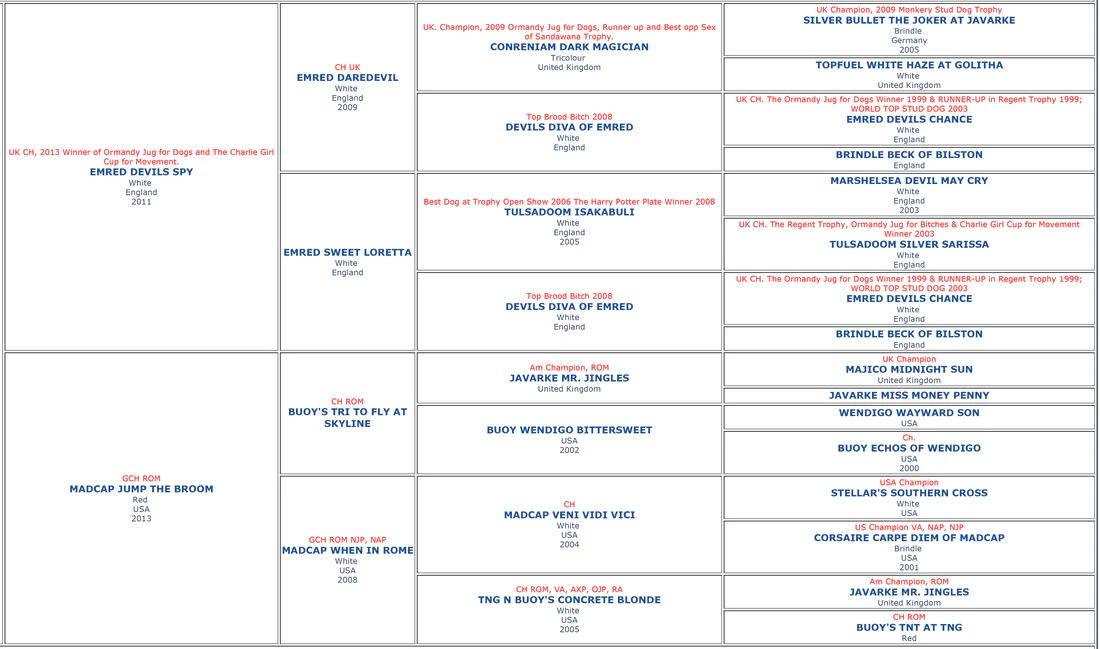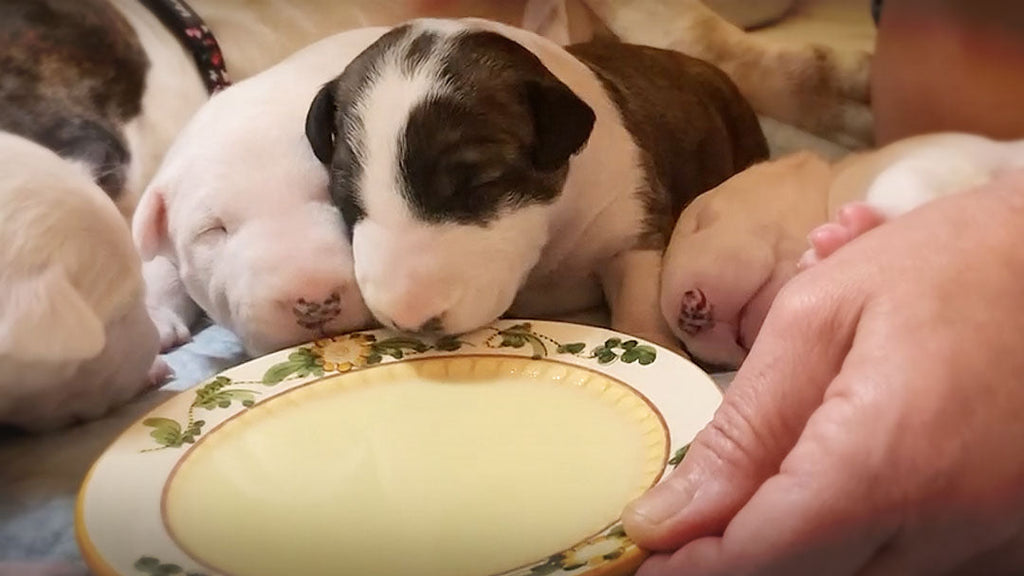Fur Dumplings
The First Day With Newborn Puppies

It's hard to believe that it's been three and a half years since we began filming Daphne and her first litter for Puppy Culture.
But the years pass by when you're not looking, and in the wee hours of Monday morning, August 10, 2015 we welcomed nine of Daphne's grandchildren into the world. Mom is our Pippi (CGH Madcap Jump The Broom ROM) and Dad is Zak (UK CH Emred Devil's Spy.)

First born

Daddy lends pre-whelping support.

First breaths. Pippi trusts me, but she really wants her baby.

Textbook whelping with nine healthy babies.


I tried to line them up per color so you could see the differences. The two reds were born a dark dust color but their color is coming through and they look like they will be rich red like momma. 9 puppies, four girls and five boys. Four white, two brindle, one black brindle, two red.
Here is their birth order/color/sex/weight at birth/24 hour birth weight.
1. White bitch (now with blue ID) - 10.8/11.1
2. Red dog - 7.5/7.5
3. Brindle dog -11.9/12.7
4. Red bitch - 6.4/6.5
5. White bitch – 9.8/9.6
6. White with right black ear dog – 9.7/9.6
7. Black brindle dog – 8.0/7.7
8. Brindle bitch – 12.0/13.1
9. White dog – 8.5/8.7

Some puppies just jump out at you from the moment they're born. This is our brindle girl.
The three littlest ones (red dog, red bitch, and black brindle dog) were clearly much younger than the rest – less hair on face and feet and had that eel-like appearance of 61 day puppies. We only did one breeding, probably a day after ovulation. It so happens that the breeding was done on the early side for logistical reasons (she was bred on the day of ovulation rather than two days afterwards, as we normally would have done with only one breeding). The semen was excellent with 96% motility, so I’m thinking it fertilized every egg in there over a period of the 3-4 days, which is why some puppies are so much younger than the others.

This was our attempt to let the little ones nurse extra while the rest of the litter napped. As you can see the largest puppy woke up and joined them.
The birth weights were lower than what we are used to in our litters – the smallest is generally more like 10 ounces with the largest to 16-17 ounces. The smaller puppy size, combined with Pippi’s statuesque physique is probably what led to such a text book whelping – we literally had not finished cleaning the previous puppy before she lifted her tail and shot another one at us. First puppy was born yesterday at 1:20 AM and last one at 5:30 AM – 9 puppies in about 4 hours.

Well done, Pippi!
We consider 7 ounces a threshold for concern, so we’re keeping a close eye on our little red girl. So far she is vigorous and shiny and shows no signs of being anything other than tiny and extremely hungry ;o). We’re giving her and her two small siblings extra rotations on the teats.

Above: She may be tiny, but she has absolutely no problem latching onto the largest teat and sucking it dry.
She may be tiny, but she has absolutely no problem latching onto the largest teat and sucking it dry.
Right: We use gel food coloring to ID all the white puppies. It has a more intense color than liquid food coloring and is 100% safe to use.

We use gel food coloring to ID all the white puppies. It has a more intense color than liquid food coloring and is 100% safe to use.
Of course we love that some of the puppies gained weight in the first 24 hours, but weight gain in the first 24 hours is a bonus. We would expect to see the puppies maintain their weight or even lose a little in the first 24 hours. A combination of the stress at birth and the nutritional composition of colostrum means that some puppies will not gain weight the first day. Pippi’s real milk should come in within the next 24 hours, so for the non-weight gaining puppies (the three littlest ones) we expect to see some gain by tomorrow. We expect to have to supplement the litter because of the number of puppies, and we may start doing this sooner rather than later if the wee ones don’t have significant gain in the next 12 hours.
In any event, if we don’t see any weight gain by three days old, that’s a major cause for concern. We’ll cross that bridge if we come to it, but not gaining weight in the first three days can be a sign of low immunoglobulin levels which associated with high neonatal mortality rate. You can read more about this and possible remedies in my article on fading puppies HERE.

Hold still, you have to poop.

Pippi

Zak
Pippi is an outstanding mother and she’s getting the hang of this motherhood thing very quickly. She has her moments of panic and confusion, but we’re very encouraged by the fact that she seems to learn quickly. She’s gotten over having to stare at them every moment to make sure they’re still there, and she will voluntarily get up and go outside to potty. She’s even appears to be learning how to move the puppies around with her nose which is very unusual for a Bull Terrier. Baby steps :o).
Postscript on the Headlamp

Everyone is asking about the headlamp so here's the info on the one I have, the LED Lenser H14.2 Headlamp - we did have to send back the first one we got as the switch was faulty, but the company gave us great customer service and replaced the unit without question. I do recommend the LED Lenser, which can be found HERE.

This article was originally updated on puppyculture.com in 2015

About the Author
Jane Messineo Lindquist (Killion) is the director of "Puppy Culture the Powerful First Twelve Weeks That Can Shape Your Puppies' Future" as well as the author of "When Pigs Fly: Training Success With Impossible Dogs" and founder of Madcap University.
Jane has had Bull Terriers since 1982 and she and her husband, Mark Lindquist, breed Bull Terriers under the Madcap kennel name.
Her interests include dog shows, dog agility, gardening, and any cocktail that involves an infused simple syrup.















